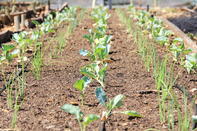Yield - Tonnes per hectare per year
Average yield per hectare is about 16 tonnes.

Harvesting
Harvesting of most commercial chive is done mechanically. On smaller production units and in greenhouses it can be done by hand although this does get expensive.
Start harvesting in the morning when the temperature is still cool, but after the leaves have dried. Harvesting of the outer leaves can start as early as 10 weeks after planting of the seeds.
Bigger commercial growers will wait longer and harvest the entire bunch, cutting the bunch off about 3 to 5 cm above the ground and making bunches of the desired size. If this is done by hand the outer leaves can be picked first or the entire bunch can be cut and size sorted.
Storage
Fresh production: After harvesting store the fresh chives at 2°C. The chives can be stored for about 5 to 7 days. The most important consideration is to keep the leaves dry in sealed bags. Fresh herbs lose their culinary flavour fast, so it is best to market and use fresh cut chives as quickly as possible.
Fresh chives can also be chopped and kept in airtight bags in a freezer.
Pests
Aphids, Cut Worms, Root Maggots and Thrips are some common pests.
Diseases
Botrytis, Downey Mildew, Pink Rot and White rot.
It is best to follow a crop protection regime as prescribed by an extension officer or agronomist. The local chemical salesmen generally have the right programmes or could provide information as to the best advisors available in close proximity to the production area.